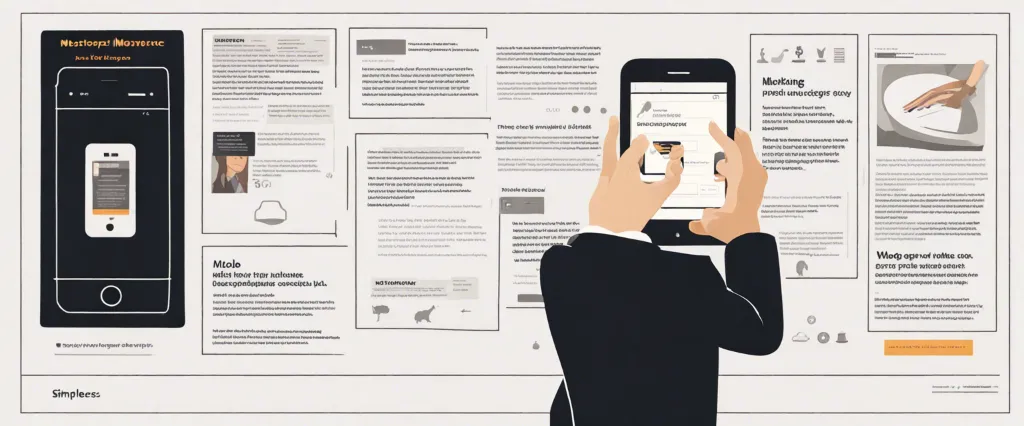In “Simple and Usable: Web, Mobile, and Interaction Design,” Giles Colborne provides a comprehensive guide on creating intuitive and efficient digital experiences. In this captivating book, Colborne emphasizes the importance of simplifying complex design problems and offers practical techniques to achieve user-centered solutions. With his vast experience as a user experience consultant and accomplished author, Colborne reveals invaluable insights that can transform the way designers approach their work, ensuring optimal usability and enhanced user satisfaction. By explaining the key principles of effective design and illustrating them with real-world examples, “Simple and Usable” serves as an indispensable resource for professionals seeking to create compelling digital experiences.
Chapter 1: The Power of Simplicity
Chapter 1 of “Simple and Usable Web Mobile and Interaction Design” by Giles Colborne, titled “The Power of Simplicity,” focuses on the importance of simplicity in design and the positive impact it has on user experiences. Colborne highlights how simplifying design not only benefits users but also makes it easier for designers to create effective interfaces.
The chapter starts by explaining the concept of simplicity and its significance in web, mobile, and interaction design. Colborne emphasizes that simplicity is not about dumbing down or removing essential features, but rather about creating intuitive and effortless experiences for users. He argues that simplicity is a powerful tool in gaining users’ trust, engagement, and loyalty.
Colborne discusses the cognitive load, the amount of information the human brain can handle at a given time. Complex and cluttered designs overwhelm users with excessive information, leading to frustration and confusion. By simplifying the design, Colborne suggests that designers can reduce cognitive load, helping users focus on relevant elements and complete tasks more efficiently.
The chapter also touches upon the myth that simplicity equals minimalism. Colborne points out that simplicity is not the absence of features, but rather an understanding of users’ goals and providing them with the most straightforward and intuitive path to achieving those goals. He advocates for designing with the user in mind, focusing on their needs and preferences rather than overly complicating the interface with unnecessary elements.
Furthermore, Colborne stresses the value of simplicity in responsive design. With the proliferation of devices and screen sizes, simplicity becomes even more critical in ensuring a seamless user experience across various platforms.
In conclusion, Chapter 1 emphasizes the importance of simplicity in design. By simplifying interfaces and reducing cognitive load, designers can create intuitive and engaging experiences that cater to users’ needs and preferences. This chapter sets the foundation for the book’s subsequent discussions on how to achieve simplicity in web, mobile, and interaction design.
Chapter 2: Understanding User Needs
Chapter 2: Understanding User Needs of the book Simple and Usable Web, Mobile, and Interaction Design by Giles Colborne focuses on the importance of understanding user needs in the process of designing effective and user-friendly digital experiences. Colborne emphasizes the significance of empathizing with users and gaining deep insights into their motivations, goals, and behaviors.
The chapter begins by highlighting the common mistakes designers make when they rely solely on the assumptions or perspectives of stakeholders. Colborne stresses the importance of conducting user research and gathering real data to create meaningful designs. He introduces several user research methods such as interviews, observations, surveys, and user testing, highlighting their benefits and when to use them.
Colborne emphasizes the need to identify the core needs of users and how they relate to the design objectives. He discusses the importance of context in understanding user needs and highlights the significance of considering users’ mental models, expectations, and preferences. Colborne also emphasizes the importance of considering diverse user groups and accommodating their specific needs and capabilities.
Furthermore, the chapter delves into the concept of personas and how they can help designers understand their users better. Colborne explains how personas help designers empathize with users by making research findings more tangible and relatable. He provides practical tips on creating effective and meaningful personas, such as basing them on data rather than assumptions and ensuring they represent a diverse range of user behaviors and needs.
In summary, Chapter 2 emphasizes the need for designers to deeply understand user needs through research and data collection. By empathizing with users and developing personas, designers can create more effective and user-centric designs that align with users’ motivations and behaviors.
Chapter 3: Designing for Clarity
Chapter 3 of “Simple and Usable Web, Mobile, and Interaction Design” by Giles Colborne focuses on designing for clarity. The author emphasizes that clarity should be the primary goal of any design, as it helps users understand how to use a product or website without confusion or frustration.
Colborne begins by discussing the importance of visual hierarchy in achieving clarity. He explains that visual hierarchy helps users easily navigate through content by providing a clear order of importance. This can be achieved through the use of headings, subheadings, bullet points, and consistent formatting choices.
The author then explores the concept of simplicity in design. He argues that simplicity should be the foundation of any design, as it decreases cognitive load and increases user engagement. Colborne suggests avoiding unnecessary elements and focusing on providing only the essential information and functionality.
Colborne also delves into the significance of consistency in design. He explains that consistency creates predictability for users, allowing them to transfer their knowledge from one part of a website or app to another. Consistency can be achieved through the use of consistent visual and interaction patterns, as well as adhering to established UX conventions.
Additionally, the chapter highlights the importance of using plain language in design. Colborne explains that using plain language benefits users by making information easier to understand and reducing the chance of misinterpretation. He suggests avoiding jargon and using clear and concise language in user interfaces.
To conclude, Chapter 3 of “Simple and Usable Web, Mobile, and Interaction Design” emphasizes that designing for clarity should be a priority for designers. By focusing on visual hierarchy, simplicity, consistency, and plain language, designers can create user-friendly experiences that are easy to understand and navigate.
Chapter 4: Creating Intuitive Interactions

Chapter 4 of “Simple and Usable Web Mobile and Interaction Design” by Giles Colborne focuses on creating intuitive interactions in design.
The chapter emphasizes the importance of designing interactions that feel natural and require minimum cognitive effort from users. It starts by discussing the human predisposition to leapt at patterns, enabling us to learn and recognize common behaviors more easily. Colborne emphasizes the need for designers to take advantage of this innate tendency by creating intuitive interfaces.
To achieve intuitive interactions, designers should align their design with users’ mental models. Colborne introduces the concept of a mental model as the users’ understanding of how a system works based on their past experience. Designers can tap into users’ mental models by using familiar analogies and metaphors that resemble real-world objects and behaviors. This approach can make the interaction more intuitive and easier to learn.
Furthermore, Colborne explains the importance of providing immediate and informative feedback to users. By providing feedback, users can be reassured that their actions have been recognized, reducing any uncertainty or frustration. This feedback can be in the form of visual cues, animations, or sound.
Colborne also highlights the significance of progressive disclosure in intuitive interactions. Progressive disclosure is the notion of presenting information gradually, in a sequential manner, rather than overwhelming users with all the information at once. This approach can prevent users from feeling overwhelmed and allow them to focus on relevant information or actions.
In conclusion, Chapter 4 of “Simple and Usable Web Mobile and Interaction Design” emphasizes the need for designers to create intuitive interactions by aligning with users’ mental models, providing immediate feedback, and implementing progressive disclosure. By doing so, designers can create interfaces that feel natural and require minimal cognitive effort from users.
Chapter 5: Enhancing Usability with Visual Design
Chapter 5 of “Simple and Usable Web, Mobile, and Interaction Design” by Giles Colborne focuses on enhancing usability through visual design. Colborne emphasizes the significance of visual design in making products more enjoyable and user-friendly.
The chapter begins by discussing the importance of creating a visual hierarchy to guide users’ attention and help them navigate through the interface. Colborne explains the concept of visual weight and how it can be utilized to prioritize important elements on the screen. He also highlights the use of white space to avoid clutter and create a more organized layout.
Colborne then explores the impact of typography on usability. He emphasizes the importance of selecting appropriate fonts that are easy to read and evoke the desired emotions. He provides tips on choosing font sizes, line spacing, and alignment to enhance readability and user experience.
Next, the author delves into the use of color in visual design. Colborne explains the psychological impact of colors and how they can be utilized to convey meaning and influence user behavior. He emphasizes the significance of color contrast and provides guidelines for selecting colors that comply with accessibility standards.
Furthermore, the chapter delves into the role of imagery in enhancing usability. Colborne discusses the importance of using relevant and high-quality images that support the content and engage the users. He also explores the usage of icons and illustrates techniques for creating visually appealing and recognizable icons.
In summary, Chapter 5 of “Simple and Usable Web, Mobile, and Interaction Design” focuses on enhancing usability through effective visual design. Colborne covers various aspects including visual hierarchy, typography, color, imagery, and icons, providing designers with practical guidance to create engaging and user-friendly interfaces.
Chapter 6: Designing for Mobile Experiences
Chapter 6 of “Simple and Usable Web Mobile and Interaction Design” by Giles Colborne focuses on designing mobile experiences. The chapter details various considerations and strategies to create effective mobile interfaces that prioritize simplicity and usability.
The chapter begins by emphasizing the importance of understanding user behavior on mobile devices. Mobile users often have different goals and contexts compared to desktop users, leading to different design requirements. Colborne advises designers to identify the key tasks users want to accomplish on mobile and adapt the interface accordingly. Prioritizing content, minimizing the need for excessive scrolling, and providing clear navigation are key principles for effective mobile design.
Next, the chapter explores the role of touch interfaces in mobile design. Colborne highlights the need for simplicity and clarity in touch interactions, such as using large buttons and avoiding cluttered interfaces. He also discusses the importance of considering the placement and spacing of interactive elements to prevent accidental taps.
Colborne then delves into the concept of responsive design, which ensures interfaces adapt to different screen sizes and orientations. He explains that responsive design allows for optimal user experiences across various devices, from smartphones to tablets. He advises designers to focus on content hierarchy and consider the limited screen real estate on mobile devices when designing responsive layouts.
The chapter also emphasizes the significance of performance optimization in mobile design. With slower internet connections and limited battery life, mobile users value fast and efficient experiences. Colborne suggests reducing page weight, avoiding excessive animations, and optimizing images to ensure fast loading times.
In summary, Chapter 6 provides insights and guidelines to design effective mobile experiences. It emphasizes understanding user behavior, simplifying touch interactions, employing responsive design principles, and optimizing performance to create intuitive and user-friendly mobile interfaces.
Chapter 7: Designing for Accessibility and Inclusivity
Chapter 7 of “Simple and Usable: Web, Mobile, and Interaction Design” by Giles Colborne focuses on designing websites and applications that are accessible and inclusive for a diverse range of users. The chapter emphasizes the importance of making digital products usable by people with disabilities and provides practical strategies for achieving this goal.
The chapter begins by discussing the concept of accessibility and highlighting the need to consider different types of disabilities, such as visual impairments, motor impairments, and cognitive impairments, while designing interfaces. Colborne emphasizes that accessibility is not just about following guidelines, but also about understanding the needs and capabilities of users.
The author introduces the concept of universal design, which aims to create products that can be used by as many people as possible without the need for specialized adaptations. Colborne presents various design principles and techniques, such as providing alternative text for images, ensuring clear and concise content, and making the navigation simple and consistent.
The chapter also addresses the importance of inclusive design, which involves considering the needs of different user groups, including those from different cultures or with diverse socio-economic backgrounds. Colborne highlights the significance of inclusive language, culturally sensitive design, and accommodating different reading levels.
Additionally, the chapter emphasizes the importance of involving people with disabilities in the design process through user testing and feedback. Colborne provides examples of how involving users with disabilities can lead to valuable insights and improvements in the design.
Overall, Chapter 7 of “Simple and Usable” underscores the significance of designing for accessibility and inclusivity in web and mobile interfaces to ensure a positive user experience for all users, regardless of their abilities or backgrounds.

Chapter 8: Iterative Design and Continuous Improvement
Chapter 8 of “Simple and Usable Web, Mobile, and Interaction Design” by Giles Colborne focuses on the importance of iterative design and continuous improvement in the design process. Colborne emphasizes that good design is not achieved in a single step, but through a series of iterations and continuous refinements.
The chapter starts by discussing the benefits of an iterative design approach. Colborne explains that iterative design allows designers to gather feedback early on and make adjustments, leading to improvements in usability and user satisfaction. He emphasizes the importance of involving users in the design process and conducting user testing throughout the iterations.
Colborne introduces the concept of the double diamond process, which consists of four phases: discover, define, develop, and deliver. He explains how each phase involves iterative cycles of research, ideation, prototyping, and testing. This process ensures that ideas are thoroughly explored, refined, and validated through user feedback before being implemented.
Furthermore, the chapter discusses the concept of “designing for the long term” and the role of continuous improvement in maintaining a successful product. Colborne highlights the importance of gathering data, analyzing user behavior, and making refinements based on these insights. He stresses that design should be an ongoing process rather than a one-time event.
Colborne also addresses the challenges and constraints designers face during the iterative design process, such as limited resources, time pressures, and conflicting stakeholder interests. He provides practical advice on how to navigate these challenges and discusses the importance of maintaining a balance between quick iterations and thorough refinement.
Overall, Chapter 8 emphasizes the significance of iterative design and continuous improvement in creating effective and user-centered designs. By embracing the iterative process and actively seeking user feedback, designers can enhance usability, address usability issues, and ultimately create products that better meet user needs and expectations.
After Reading
In conclusion, “Simple and Usable Web Mobile and Interaction Design” by Giles Colborne serves as a comprehensive guide for designing effective digital experiences. The book emphasizes the importance of simplicity and user-centric design, providing practical tips and strategies for creating interfaces that are intuitive and easy to navigate. Colborne stresses the significance of understanding users’ needs and expectations, and provides useful techniques for conducting user research and testing. Overall, this book is an invaluable resource for designers looking to enhance the usability and accessibility of their web, mobile, and interaction designs.
1. “Don’t Make Me Think: A Common Sense Approach to Web Usability” by Steve Krug: This book, similar to “Simple and Usable Web Mobile and Interaction Design,” focuses on creating user-friendly websites and interfaces. It provides practical advice and examples to help designers make their products effortless to use.
2. The Design of Everyday Things” by Don Norman: Don Norman, a renowned expert in user-centered design, explores the psychology behind interactions with objects and technology. This book delves into how design affects user experience and offers valuable insights for anyone involved in designing interactive systems.
3. “Mobile Usability” by Jakob Nielsen and Raluca Budiu: For those specifically interested in mobile design, this book is an excellent resource. It covers various aspects of mobile usability, including navigation, form design, and overall user experience on smartphones and tablets.
4. “Designing for Interaction: Creating Smart Applications and Clever Devices” by Dan Saffer: This book provides a comprehensive overview of interaction design principles and methodologies. It covers topics such as designing for different contexts, prototyping techniques, and the social aspects of interactive products.
5. “Information Architecture: For the Web and Beyond” by Louis Rosenfeld and Peter Morville: This book focuses on organizing information in a way that makes sense to users. It delves into the planning, designing, and implementation of user-friendly information architectures, helping designers create intuitive and logical systems.



